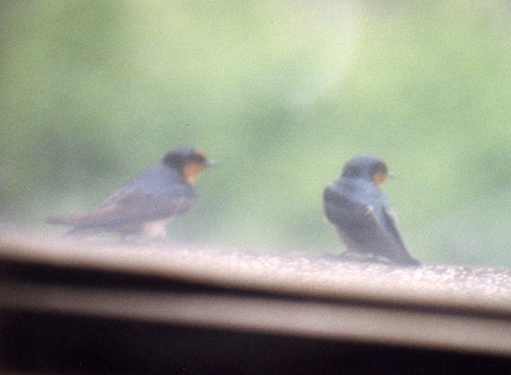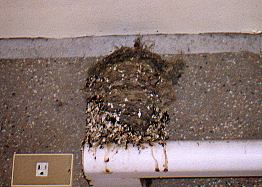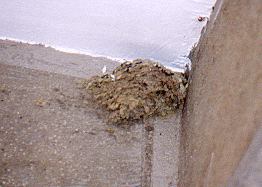|
 Few people realize that we share our school campus with a wide variety
of native wildlife. Have you noticed two inconspicuous bowls of mud plastered
to the corner of the roof in front of the lobby? These are the nests, one
apparently abandoned, of a pair of Pacific swallows, a common bird in Taiwan.
These swallows have nested outside our lobby, undisturbed by people, and
have cared for their fledglings successfully for many years. Unfortunately
this golden opportunity for educating children has been for the most part
overlooked.
Few people realize that we share our school campus with a wide variety
of native wildlife. Have you noticed two inconspicuous bowls of mud plastered
to the corner of the roof in front of the lobby? These are the nests, one
apparently abandoned, of a pair of Pacific swallows, a common bird in Taiwan.
These swallows have nested outside our lobby, undisturbed by people, and
have cared for their fledglings successfully for many years. Unfortunately
this golden opportunity for educating children has been for the most part
overlooked.
Of the 42 species of birds found on the TAS campus, Pacific swallows are one of the most easy to observe because they are often surprisingly fearless of humans; they dart into crowds during school fairs and dodge the busy traffic on the roads. Pacific swallows are small birds, about 13 cm long and have a glossy, dark blue back, grayish belly, and slightly forked tail. Their face is orange with a dark band across their eyes. Although studies show that these birds normally breed between April and June, the pair at our school seem to be actively breeding into July, when their young finally leave the nest. Beginning in April or May, the parent birds begin tidying up their nest made of mud, straw, and feathers. Then the eggs are then laid and incubation begins. After the chicks hatch, both parents busy themselves feeding the four -- usually -- hungry mouths. The parents cruise gracefully through the air, snapping up airborne insects, returning to the nest, and stuffing the insects into the mouth of the chick who is begging the loudest and whose mouth is opened the widest. The feeding is amazing to watch because the adults often do not land when they feed the chicks; the whole process only takes a split second.  Since pacific swallows breed during the summer, most students cannot observe
their breeding behavior. However, during the school year the swallows are
never far from campus, and teachers can take their students to observe
them and their unused nests. When not perched on top of the glass wall
of the lobby, the swallows often fly around the parking lots or the athletic
fields. Occasionally they perch outside classroom windows, where they can
be observed at close range.
Since pacific swallows breed during the summer, most students cannot observe
their breeding behavior. However, during the school year the swallows are
never far from campus, and teachers can take their students to observe
them and their unused nests. When not perched on top of the glass wall
of the lobby, the swallows often fly around the parking lots or the athletic
fields. Occasionally they perch outside classroom windows, where they can
be observed at close range.
Our school is privileged to have these swallows nest outside the lobby, but these birds must be protected. Although their nests the second floor roof are safely out of reach, the swallows are not totally secure from harassment or excessively loud noise; they and their young are especially susceptible to disturbance during breeding season. Most importantly, any action that might disturb the nests or any intention to remove them should be thoroughly reviewed by the entire school community. |



